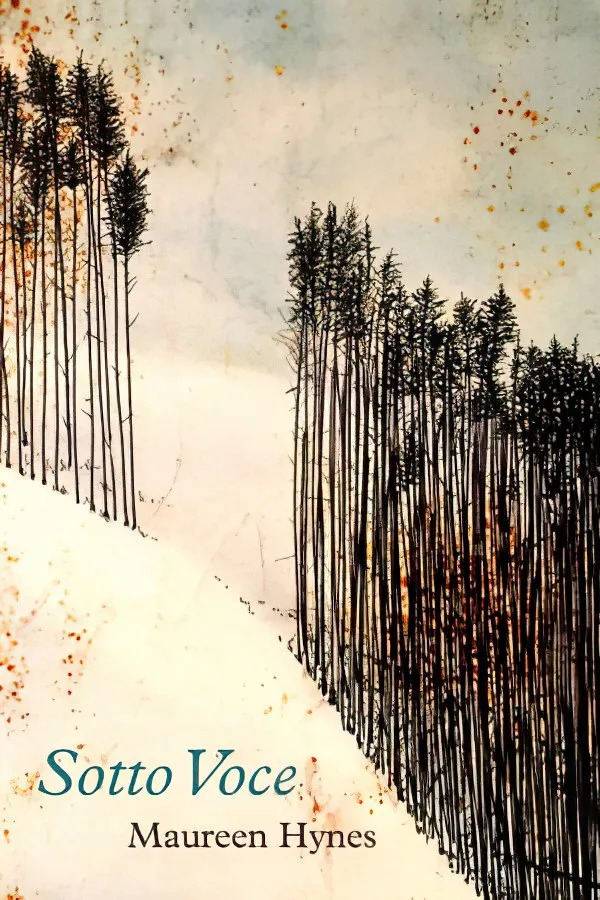Ever since Emily Dickinson told us to tell it slant, poets have approached truth indirectly from refracted angles of their individual talent. In her fifth book of poetry Maureen Hynes approaches the truth through undercurrents of sotto voce, where words are overheard in quiet cadences. The cover of Sotto Voce displays a beige slope with a stand of darker trees, and an empty space for Hynes’s voice and vision to shape the contours of mind and landscape. Part of Bob Hainstock’s series of Simple Forms, the cover image, like the poetry within, conceals the quiet complexity of understatement. Just as Hainstock dots his landscape with rust patterns, so Hynes touches rusty railings to “etch a pointillism” on her palm. Indeed, through pointillist undertones Hynes indirectly apprehends many truths.

Hynes is drawn to rivers: from her opening sonnet, “Into the Humber River,” to “High Water Mark,” she navigates their sources and mouths, exploring their tributaries where “deep time slowly flows and flows.” Upstream and downstream, she embraces the “river’s ripples,” engaging nature and humanity, local and universal flow, and the poetry of others and otherness. Between the Don River and “Little Rouge Creek,” Sotto Voce charts a quieter course where each sound and sight resonates beyond the immediate line.
“Into the Humber River” measures time according to a disabled clock, which has its hands torn off and abandoned to the weeds: “It took the time right out of us, poured / it through the small black circle in the clock’s / centre & underground into the river.” Time gets measured in the iambic march of monosyllables, the clock that connects humans and nature, caesuras of silent breathing, the enjambment, and the ampersand that resembles the disabled clock. “Those wizened ampersands / hanging from snow-threaded branches” (“In Solitary”) connect text to trees, font to still life, word to life. The poet watches the hours and minutes drain away like a blessing. “We didn’t miss it the way we’d miss / our own hands.” Literally and figuratively she takes time out to pause and connect clock, poet, and river in this moment’s monument.
Hynes’s sonnets pay tribute to Frank O’Hara, Margaret Christakos, Pablo Neruda, and many others: her poetry is generous not only toward her readers, but also to the sharing community of other poets who contribute to the slant of not-so-simple forms. “Inside My Quietness” proceeds like a series of Russian nesting dolls that move inward yet beckon outward in a bittersweet lyricism that encompasses elegiac and rhapsodic tones.
Her title poem, “Sotto Voce,” responds to David Lang’s “the whisper opera” before reaching out to Jack Spicer’s lines in “my vocabulary did this to me.” Part of a collaborative effort that reminds us that vocabulary derives from voice, the solo joins in choral harmony. Hynes modulates whispers along long, gliding lines: “your saxophone whispers its notes, when you just / graze your fingertips across the drumskin for a drumly / quietness.” She flows from the smoky liquid sounds of the saxophone to the everyday language of small rivers. Hynes incorporates the echoes and afterthoughts of other poets, one lowered voice listening to another, and paints pointillism in muted hues.
Whether paying tribute to other poets or bearing witness to the injustices of settler-colonialism or the Nazis’ murder of newborns, Hynes attunes her ear to multiple voices. From her “memory stick store” (“The Missing Island”) to her “dynamite stick of injustice” (“where does my love stop”) she bridges gaps in language and landscape. The subtleties of her voice and varied forms underscore the whisper of wisdom and the wisdom of whisper.
Bios
Michael Greenstein
Michael Greenstein has taught at the Université de Sherbrooke and the University of Toronto. He is the author of Third Solitudes: Tradition and Discontinuity in Jewish-Canadian Literature and the Poetry Editor of The Miramichi Reader. [updated in 2022]

